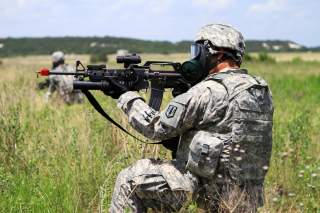America's Special Forces Are a Killing Machine. But What About Everyone Else?
Could other nations be catching up?
One of the Special Operations Forces (SOF) truths is “Humans are more important than Hardware.” However, throughout most of the global war on terror, American SOF have gone to war with some of the most technologically advanced hardware on the planet. As other nations also begin to invest and utilize their SOF, is the technological edge of American SOF being dulled?
Perhaps the greatest advance in the technology used to support SOF during GWOT was the use of Unmanned Aircraft Systems (UAS) for Intelligence, Surveillance, and Reconnaissance (ISR). The United States fielded hundreds of MQ-1 Predators and MQ-9 Reapers in support of SOF (as well as conventional operations). These “eyes in the sky” allowed the United States to track and survey targets at almost any hour of the day, via the advanced thermal- and night-vision cameras on the nose of these aircraft. Russia has fielded UAS in Syria as well, though it’s unsure how many are relegated to support of SOF operations. Reports suggest that Russian UAS in Syria are primarily used for spot and adjust for artillery, although intelligence gathered on such flights could be used to support Russian SOF as well.
As for the drones themselves, Russian forces appear to be using the Orlan-10 and Forpost UAS. The Forpost, a version of Israel’s IAI Searcher Mk. II, is a rough analog to the MQ-1 Predator, housing a camera ball and featuring similar weight, range, and endurance characteristics. However, it cannot be armed, limiting its role in providing immediate direct fire against targets. The Orlan-10 is far lighter, weighing only fifteen kilograms. It too has a stabilized camera ball, which includes thermal imagers, but the capabilities of this ball are likely less than that on heavier UAVs. The heavy use of the lighter Orlan-10 (including footage published from them in official media) is likely due to Russian preference to test their own domestic equipment, as well as the low cost of these light UAVs.
Recommended: Air War: Stealth F-22 Raptor vs. F-14 Tomcat (That Iran Still Flies)
Recommended: A New Report Reveals Why There Won't Be Any 'New' F-22 Raptors
Recommended: How an ‘Old’ F-15 Might Kill Russia’s New Stealth Fighter
China is even further ahead than Russia on this front. They field and export the Wing Loong series of UAS, which can be considered practically direct clones of the MQ-1 Predator, sharing the same bulbous nose, V tail, and importantly, armed strike capability. These UAS have been proven in combat, and have seen multiple successful export contracts. While Chinese doctrine regarding their SOF is rather opaque, it’s highly likely that these UAS would support Chinese SOF on the battlefield.
While technology has also advanced in other areas regarding SOF support, development in those areas is often opaque and hidden. What is visible though is the development in the infantry equipment SOF use. As SOF often operate independently of heavy ground assets, they are often known to use specialized firearms and equipment relative to their conventional counterparts.
The primary innovations in this field for the United States have been the development of advanced imaging technology for the infantry, from miniaturized thermal sights to improvements in night vision. While night vision has been on the “third generation” for almost two decades now, significant improvements have been made in resolution, image clarity, and field of view. One technology that’s enabled this is the use of white phosphor instead of green phosphor in the tubes used to make NVGs. This provides increased detail and less “bloom” in the picture, as well as decreased eye strain. These are implemented in the AN/PVS-31 NVGs which are currently in use by U.S. forces. Other innovations include the AN/PSQ-20 and AN/PSQ-36 systems which overlay thermals over night vision in what’s called “fusion vision” that allows the operator to take the best of both thermal- and night-vision systems. There’s also the famous GPNVG-18, which features four tubes which allows for a greater field of view under night vision.
These innovations don’t appear to have filtered down to Russian SOF. Even in motivational shots, they appear to be using only monoculars. While Russian (and Belarussian) industries have produced night-vision binoculars, there are no pictures of them in use in the field. Russian doctrine traditionally has favored the use of night-vision devices attached to weapons, such as in the NSPU-series and 1PN93 of night vision weaponsights.
While effective, these systems are more useful in defensive positions and for surveillance. This trend appears to continue to the present day, as Russian SOF have been spotted with thermal weaponsights, and the new Ratnik future soldier system appears to use a monocular that could be used to view the picture from a weaponsight, which might have thermal or night vision properties. The Ratnik program is said to include thermal- and night-vision devices, but information about these are scarce and don’t appear to be rolling out at the same pace as the other parts of the Ratnik program.
Information on the PLA’s night vision technology is scarce, but reports suggest that they’re using a simple binocular type device which is unlikely to use new technologies like white phosphor. Releases from the People’s Daily Online in 2014 show single tube devices similar to the AN/PVS-7 (which entered U.S. service in 1985 and had a very limited field of view). Interestingly, they appear to use a bracket that mounts the night-vision devices on a hinge at the chin to flip down, as opposed to flipping up like Russian and American devices.
Charlie Gao studied Political and Computer Science at Grinnell College and is a frequent commentator on defense and national security issues.
Image: Flickr

